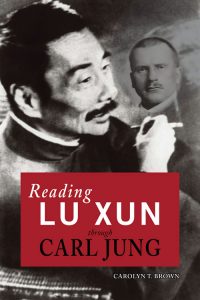The following is an interview with Dr. Carolyn T. Brown, author of the new book Reading Lu Xun Through Carl Jung, which is part of the Cambria Sinophone World Series, headed by Victor Mair (University of Pennsylvania).
 Why did you decide to write Reading Lu Xun Through Carl Jung?
Why did you decide to write Reading Lu Xun Through Carl Jung?
Carolyn T. Brown: The seeds of this book lie in the mid-1980s when I was an academic in Chinese literature. My career took a turn away from academia, and the book sat in the drawer for several decades. But the nascent book wouldn’t allow me to forget it. So after I retired, I refurbished my reading knowledge of Chinese and finished the book. Somewhere during those decades I encountered the work of Carl Jung and over time, the resonances between the two emerged naturally for me. In the end, there were two questions that drove Reading Lu Xun Through Carl Jung: why were Lu Xun’s stories so personally compelling to me and what did he mean by wanting to cure the spirits of the Chinese people. I found these questions so compelling that in the end it was easier to write the book than to not write it.
What do you hope your readers take away from your book?
CTB: Naturally I hope that readers will gain a more precise appreciation for Lu Xun’s psychological depth and masterful techniques, and also a deepened sense of why he might have been, and still is, important in China. For those not overly interested in China but deeply interested in literature and psychology, I hope my analysis will suggest new historical connections between Chinese and Western literature. I am well aware that it is out of fashion to speak of certain universal features of human life, which is labeled “essentializing,” and I understand that superficial statements about how “we’re all the same” usually involve colonialist impositions by “us” onto the “them.” Nevertheless, human beings do wrestle with some of the same deep issues, and the human similarities lie at that level of questions, not necessarily of answers. For example, Lu Xun deeply pondered the issue of scapegoating, and as best I can tell, that psychological syndrome has been alive and well in all societies over time. So I hope readers will see, in addition to the enormous differences of history and culture, similarities in the issues that troubled this sensitive man and that still trouble us today. In addition I hope that readers in China will find that my reading of Lu Xun gives them further permission to think about their great writer not just in terms of history and politics, which have been, quite appropriately, the driving force in Chinese interpretations of his work, but also will find in the book a further way of appreciating his sensitive pondering of illness and health at multiple levels of society and self, questions that are perennial.
What other research do you believe is useful on Lu Xun’s work?
CTB: The book itself suggests two questions ripe for further study. Scholars who have wondered about the influence of Western literature on Lu Xun’s short stories have focused on issues of content. My book suggests influence in structural elements, in particular Lu Xun’s use of the literary techniques of doubling and splitting, which was prevalent in nineteenth-century Europe. I would love to see someone take a list of the books that he was known to have read and trace parallels in the literary techniques that he used, not just those of doubling and splitting, but multiple “tricks of the literary trade,” including use of quotation and summary, ordering of plot elements, and so forth. A good knowledge of literary techniques in the Chinese tradition would help reveal what exactly Lu Xun did that was new to China and probably also what was different from the same Western writers.
Another issue that surfaced but which I wasn’t able to pursue was a new way of thinking about Nietzsche’s influence on Lu Xun. Prior studies that I encountered looked at issues of content. I stumbled upon parallels in the way each man frames his questions, and in fact these parallels in structure shed light on the works of Carl Jung as well. I suspect that there is a lot more to discover about the structure of thinking of these two when viewed together. It is even possible that a focus on structure will illuminate the work of other writers and thinkers of that period.
About the author: Carolyn Thompson Brown is retired from her position as Director of the Office of Scholarly Programs and the John W. Kluge Center of the Library of Congress. She holds a PhD in Literature from American University and an MA and BA from Cornell University. She served as Associate Dean for Humanities at Howard University before moving to the Library of Congress, where she held numerous positions including Director of Area Studies Collections. During her academic career she published in several journals, including CLEAR and Modern Chinese Literature, and edited Psycho-sinology: the Universe of Dreams in Chinese Culture. She serves as a trustee of the Fetzer Institute.
 Title: Reading Lu Xun Through Carl Jung
Title: Reading Lu Xun Through Carl Jung
Author: Carolyn T. Brown
Publisher: Cambria Press
ISBN: 9781604979374
312 pp. | 2018 | Hardback & E-book
Webpage: http://www.cambriapress.com/books/9781604979374.cfm
Watch and read the transcript of Dr. Brown’s speech for her book launch at the Cambria Press AAS reception at the 2018 conference in Washington, DC.
Dr. Brown will be speaking about her book next at the Jung Society of Washington on May 11.